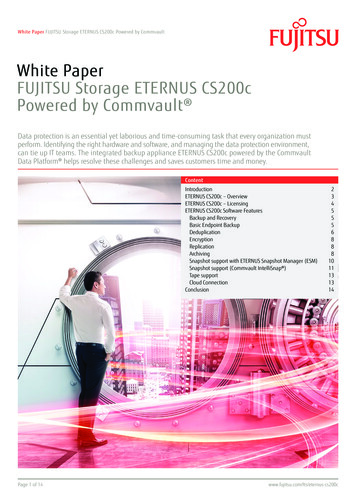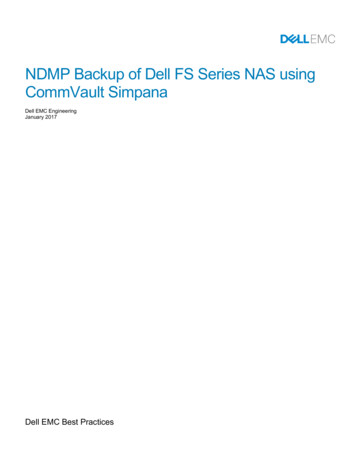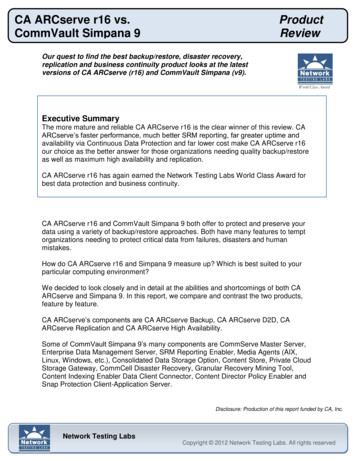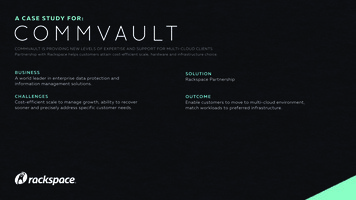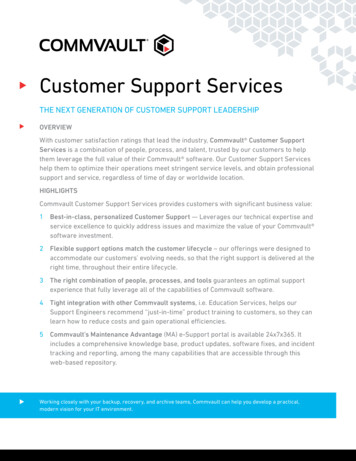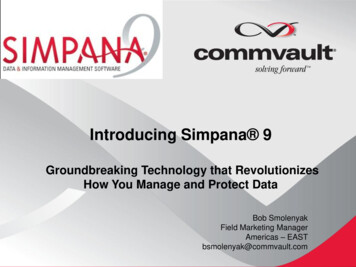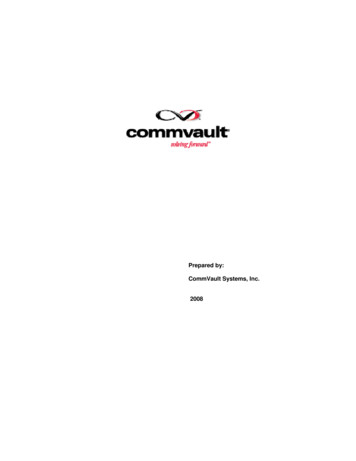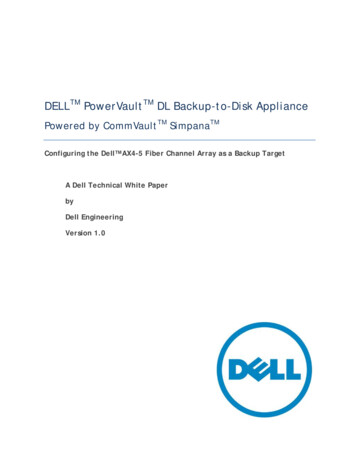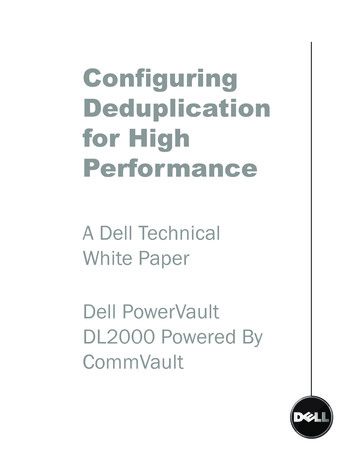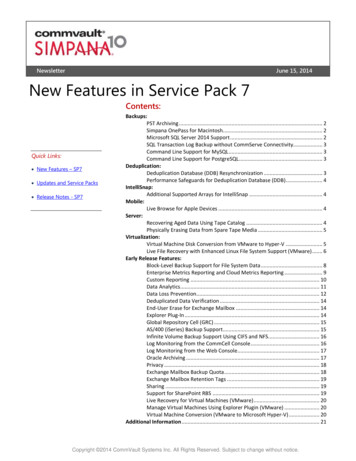
Transcription
NewsletterJune 15, 2014New Features in Service Pack 7Contents:Quick Links: New Features – SP7 Updates and Service Packs Release Notes - SP7Backups:PST Archiving . 2Simpana OnePass for Macintosh. 2Microsoft SQL Server 2014 Support . 2SQL Transaction Log Backup without CommServe Connectivity. 3Command Line Support for MySQL . 3Command Line Support for PostgreSQL . 3Deduplication:Deduplication Database (DDB) Resynchronization . 3Performance Safeguards for Deduplication Database (DDB) . 4IntelliSnap:Additional Supported Arrays for IntelliSnap . 4Mobile:Live Browse for Apple Devices . 4Server:Recovering Aged Data Using Tape Catalog . 4Physically Erasing Data from Spare Tape Media . 5Virtualization:Virtual Machine Disk Conversion from VMware to Hyper-V . 5Live File Recovery with Enhanced Linux File System Support (VMware) . 6Early Release Features:Block-Level Backup Support for File System Data . 8Enterprise Metrics Reporting and Cloud Metrics Reporting . 9Custom Reporting . 10Data Analytics. 11Data Loss Prevention . 12Deduplicated Data Verification . 14End-User Erase for Exchange Mailbox . 14Explorer Plug-In . 14Global Repository Cell (GRC) . 15AS/400 (iSeries) Backup Support. 15Infinite Volume Backup Support Using CIFS and NFS . 16Log Monitoring from the CommCell Console . 16Log Monitoring from the Web Console . 17Oracle Archiving . 17Privacy . 18Exchange Mailbox Backup Quota . 18Exchange Mailbox Retention Tags . 19Sharing . 19Support for SharePoint RBS . 19Live Recovery for Virtual Machines (VMware) . 20Manage Virtual Machines Using Explorer Plugin (VMware) . 20Virtual Machine Conversion (VMware to Microsoft Hyper-V) . 20Additional Information . 21Copyright 2014 CommVault Systems Inc. All Rights Reserved. Subject to change without notice.
NewsletterPage 2June 15, 2014PST ArchivingMicrosoft Outlook Data Files, such as Personal Folder Table (PST) files mayreside on a user's local computer, network shares, or both. The number andsize of PST files can increase rapidly when users exchange emails and performother tasks such as add calendar items, tasks and journal entries, etc. PSTArchiving provides an enterprise solution for effectively managing PST files,whether on local workstations, shared locations, or both, by archiving them tosecondary storage, and making them available to end-users from thatlocation. A few of the features of PST Archiving are: Reduce the CommServeViewandanddecreaserecover s runningOutlook, OutlookWebsimultaneouslyby runningAccess, erveconnectivity. Browse, search for, and restore emails from archived PST files.Permanently delete PST files from their source location and keep justthe archived copies on secondary storage to meet compliancerequirements.Collect PST files that are stored on laptops and desktopsautomatically by using the Laptop Backup feature.Detect who owns PST files based on files, laptops, or the user homefolder on a network share.Reclaim space on secondary storage by aging specific messagesbased on their receipt time.Users can recover archived messages using Outlook Add-In, OutlookWeb Access (OWA), Universal Recall Link, and the Web Console.Setup Requirements Prerequisites - Archiving Personal Storage Table (PSTs)Recommendations Prevent the creation and modification of PST files.Detach the PST files from the default Outlook profile.More Information Overview - Archiving Personal Storage Table (PSTs)Simpana OnePass for MacintoshSimpana OnePass for Macintosh File System is integrated with the File SystemAgent as a method to archive files which have been backed up. A Finder plugin enables users to recall archived data right from the Finder.More Information Overview - Simpana OnePass for Macintosh File SystemMicrosoft SQL Server 2014 SupportThe Microsoft SQL Server agent can now be installed on computers hostingMicrosoft SQL Server 2014 Editions.Copyright 2014 CommVault Systems Inc. All Rights Reserved. Subject to change without notice.
NewsletterPage 3June 15, 2014More Information System Requirements - Microsoft SQL Server iDataAgentSQL Transaction Log Backup withoutCommServe ConnectivityRun transaction log backups without CommServe connectivity to reduce theCommServe load and to decrease the total number of jobs runningsimultaneously.More Information Running Transaction Log Backups without CommServe ConnectivityCommand Line Support for MySQLPerform instance and subclient configuration from the Command LineInterface using XML template files.More Information Command Line Interface - MySQL AgentCommand Line Support for PostgreSQLPerform instance and subclient from the Command Line Interface using XMLtemplate files.More Information Command Line Interface - PostgreSQL AgentDeduplication Database (DDB)ResynchronizationUse DDB Resynchronization to reconcile inconsistencies between the DDB andthe CommServe database. The DDB is brought online and reverted to areusable state from maintenance mode.DDB Resynchronization prevents sealing of the DDB after the CommServeDisaster Recovery (DR) restore, thus saving significant disk space on the disklibrary.More Information DDB ResynchronizationCopyright 2014 CommVault Systems Inc. All Rights Reserved. Subject to change without notice.
NewsletterPage 4June 15, 2014Performance Safeguards for DeduplicationDatabase (DDB)You will now receive DDB threshold events and alerts on slow performingDDBs in the CommCell. The performance of the DDB is measured by theAverage Query and Insertion (QI) time threshold. The alerts are enabled bydefault and will be generated when the QI time of the DDB reaches 70%, 80%,90% of the two milliseconds threshold.More Information Deduplication database reaching QI time thresholdAdditional Supported Arrays for IntelliSnapIncrease hardware choiceand extend the value ofyour storage investmentsby automating snapshotsacross the industry's widestselection of storage arrays.IntelliSnap technology normalizes snapshot operations so they look the sameand operate the same way regardless of application or storage platform.Increase hardware choice and extend the value of your storage investments byautomating snapshots across the industry's widest selection of storage arrayswithout custom scripting for: Dell, EMC, Fujitsu, Hewlett Packard, Hitachi DataSystems, IBM, NetApp, and Nimble Storage.Support for many more arrays has been added in Version 10. Huawei, OracleZFS, DataCore SANsymphony-V, and Fujitsu DX3 are some examples of thenew array support.More Information Snapshot ManagementLive Browse for Apple DevicesUse the CommVault Edge mobile app to browse the entire contents of yourcomputer: both backed up and non-backed up data.More Information Browsing Live Data (Live Browse)Retrieve Disaster Recovery(DR) backup jobs from tapemedia and recover datafrom a deleted entity.Recovering Aged Data Using Tape CatalogData loss due to accidental deletion or technical failure can negatively affectongoing operations, requiring speedy data recovery. The preferred method isto recover data from a disaster recovery backup, but if one does not exist, youcan use the Tape Catalog feature if the data was backed up to tape media.Using this feature, the tapes can be catalogued, and the jobs contained on itcan be merged back into the database so that they are restorable.Key Features Retrieve Disaster Recovery (DR) backup jobs from tape mediaCopyright 2014 CommVault Systems Inc. All Rights Reserved. Subject to change without notice.
NewsletterPage 5June 15, 2014Restore Disaster Recovery backup jobs available on media present inone CommServe using another CommServe or a freshly installedCommServe. Recover data from a deleted entityRecover data from the backup jobs associated with the deleted entity(client, backup set, storage policy, or copy) if the actual data is stillavailable on a tape media. Restore data jobs from tape media from any CommCellView tape origin (CommCell it belongs to) and tape contents usingthe catalog feature. Restore jobs on the tape to the CommServedatabase, using the merge operation.Supported Platforms Windows and LinuxSupported Agents File SystemMore Information Recovering Aged Data - Getting StartedPhysically Erasing Data from Spare Tape MediaYou can now select to run a Full Erase operation to erase all data from thespare tape media. The Full Erase operation physically erases the data from thespare tape media, unlike the Quick Erase operation, where the data is erasedlogically by overwriting the OML (On-Media-Label).More Information Erase Spare MediaVirtual Machine Disk Conversion from VMwareto Hyper-VDisk conversion can beused to move data fromone platform to another, oras the first step inmigrating a virtualmachine.As part of the process of restoring virtual machine disk files, you can convertdisks to a new format: VMware virtual machine disks in the VMDK format can be convertedto VHD or VHDX. Hyper-V disks in the VHDX format can be converted to VMDK.After converting a disk, you can attach it to an existing VM or use it to create anew VM. Disk conversion can be used to move data from one platform toanother, or as the first step in migrating a virtual machine.Disk conversion is supported from full or incremental backups, for bothWindows and Linux VMs and for disks using thin or thick disk provisioning.Copyright 2014 CommVault Systems Inc. All Rights Reserved. Subject to change without notice.
NewsletterPage 6June 15, 2014Virtual machines created from converted disks can be backed up and restoredusing the same processes as virtual machines created directly in VMware orHyper-V.Disk conversion is not supported from differential backups, or for virtualmachines with multiple snapshots.Applicable Agents Virtual Server Agent for VMwareVirtual Server Agent for Microsoft Hyper-VIntelliSnap for VMwareIntelliSnap for Microsoft Hyper-VLicenses Virtual Server (for streaming backups)Hardware Snapshot Enabler (for IntelliSnap)More Information For Virtual Server Agent for VMware, see Converting Virtual MachineDisks.For IntelliSnap for VMware, see Converting Virtual Machine Disks.For Virtual Server Agent for Microsoft Hyper-V, see Converting VirtualMachine Disks.For IntelliSnap for Microsoft Hyper-V, see Converting Virtual MachineDisks.Live File Recovery with Enhanced Linux FileSystem Support (VMware)Live File Recovery provides expanded file system support, including ext4, andenables live browse of backup data without requiring granular metadatacollection during backups. This feature supports restores of files and foldersfrom backups of Windows VMs and of Unix VMs that use ext2, ext3, ext4, XFS,JFS, or Btrfs file systems.Live File Recovery can also be used when reducing backup times is a priority.This is a tradeoff; using this feature reduces backup time but increases thetime required to browse files and folders.To recover files or folders from a backup, you can enable backup data to bemounted as a temporary NFS datastore that can be used to browse andrestore file and folders.Applicable Agents Virtual Server Agent for VMwareIntelliSnap for VMwareLicenses Virtual Server (for streaming backups)Hardware Snapshot Enabler (for IntelliSnap)Copyright 2014 CommVault Systems Inc. All Rights Reserved. Subject to change without notice.
NewsletterPage 7June 15, 2014Setup Requirements You must deploy and use a Linux MediaAgent for File Recovery toaccess the data in the backup. See Deploy a Virtual Machine for LinuxFile Restores.Identify the proxy ESX server to be used to mount the NFS datastoreusing the Advanced Options tab on the subclient properties.The ESX server used to mount the NFS datastore for the browse andrestore must be able to resolve the Linux MediaAgent for FileRecovery. To ensure connectivity, create a host file entry for the LinuxMediaAgent for File Recovery on the ESX server.More Information Virtual Server Agent for VMware: Live File Recovery.IntelliSnap for VMware: Live File Recovery.Deploy a Virtual Machine for Linux File Restores.Specify the Default MediaAgent for a Virtual Server Instance.Copyright 2014 CommVault Systems Inc. All Rights Reserved. Subject to change without notice.
NewsletterPage 8June 15, 2014Early Release FeaturesLearn how the newest Simpana features will provide you with a businessadvantage. Explore these Early Release features for an advanced look at thevery latest capabilities we are adding, and even submit feedback to helpshape the feature. All of these features have already undergone thoroughtesting and will be generally available soon, but have not yet been officiallyreleased. For general information about Early Release features, see EarlyRelease.Block level backups offerbetter performance over filesystem-based backups inenvironments that typicallycontain a large number ofsmall files.Block-Level Backup Support for File SystemDataUse block-level backups to back up physical disk blocks of file system datausing native snaps or hardware snap engines. Block level backups offer betterperformance over file system based backups in environments that typicallycontain a large number of small files.Key Features Faster backups as only the physical disk blocks that contain the dataare backed up.Better performance over disk-image based backups when performedon a complete volume by reducing the scan time, particularly if thefile system has a large number of small files.Block-level incremental backups run faster and back up lesser datawhen the file system has very large files.File system scan is optional. You can enable file system scan duringbackups if you want to view a list of backed up items or to browse orsearch for a particular file based on the file properties like file nameand so on.Applicable Agents AIX File SystemLinux File SystemLicense Server File SystemSetup Requirements MediaAgent and File System components must be installed on the clientcomputer. On AIX, QSnap must also be included.Service Pack 7 or later must be installed for these components:o CommServeo Clients and MediaAgents used to perform block-level backupsMore Information Block-Level Backup - OverviewCopyright 2014 CommVault Systems Inc. All Rights Reserved. Subject to change without notice.
NewsletterPage 9June 15, 2014Enterprise Metrics Reporting and Cloud MetricsReportingOften, companies are forced to use disparate, third-party reporting tools inaddition to data management software to track operations and cost. Simpanaempowers you to access the information you need to make vital decisions andachieve operational excellence from a single console.Use Enterprise and Cloud Metrics Reporting to help deliver IT as a Service,plan infrastructure costs, and provide insight on operations. Monitor activityacross all CommServe computers in your organization with a complete set ofdynamic reports, including the new Worldwide Dashboard, Health Report,Activity Report, and Chargeback Report. Use scheduling and alerts toautomate system checks and report delivery.Monitor activity across allCommServe computers inyour organization with acomplete set of dynamicInstall your own Enterprise Metrics Reporting Server to host reports on WebConsole, or allow us to host your reports on our secure Cloud Services Website.Key Features Dashboard for the Worldwide and CommCell LevelPreview the most critical information at a glance, such as met andmissed SLA, storage space, failed backup jobs, and performancestatistics, gathered from all your CommCell computers and displayedin simple, customizable charts, graphs, and tables.reports.For more information, see Worldwide Dashboard and CommCellDashboard. Scheduling and E-mailing ReportsSchedule reports to automatically e-mail to vital consumers, such asmanagers and executives.For more information, see Schedule Reports. Alerts on ReportsSet alerts to notify you when CommCell computers reach a specificthreshold, such as the maximum SLA percentage. Alerts can beconfigured as SNMP traps, e-mails, events in CommCell Console, andnotifications in Windows Events Viewer.For more information, see Alert Notifications. Software StoreDownload new reports from the Software Store as soon as they areavailable.For more information, see Download Reports from Software Store. Health ReportUse the Health Report to identify the clients and policies that need tobe adjusted to maintain optimal performance for your CommCellcomputers. Information includes the status of backup operations, thelatest installed versions of software, and disaster recovery settings.Copyright 2014 CommVault Systems Inc. All Rights Reserved. Subject to change without notice.
NewsletterPage 10June 15, 2014For more information, see Health Report – Overview. Activity ReportUse the Activity Report to monitor current and historical data on thesuccess of backup operations, strike counts, and frequent errors overthe last week or the last year.For more information, see Activity Report – Overview. Chargeback ReportTrack the cost of storage for your customers or internal departments.For more information, see Chargeback Report – Overview.License Advanced ReportingSetup Requirements Enable data collection for reports in the CommCell Console ControlPanel.To host your own reports, install an Enterprise Metrics ReportingServer.Recommendations Install the Enterprise Metrics Reporting Server on the same computeras the CommServe software and the Web Server.Set up both Cloud Metrics Reporting Server and Enterprise MetricsReporting Server in order to take advantage of all reporting features.More Information View reports that includethe information you mostwant to see and share yourreports with other users inyour organization.Enterprise Metrics ReportingCloud Metrics ReportingCustom ReportingBuild reports based on your organization’s unique needs. View reports thatinclude the information you most want to see and share your reports withother users in your organization.Key Features Use multiple data sourcesInclude data from the CommServe database or the data in yourorganization's database, such as SQL, MySQL, and Oracle. Publish reports to Download CenterYou can make reports that you build or download available to otherusers in your organization by publishing the reports to the DownloadCenter on Web Console. Deploy reports for offline data collectionCopyright 2014 CommVault Systems Inc. All Rights Reserved. Subject to change without notice.
NewsletterPage 11June 15, 2014If you host reports for multiple CommServe computers, you cancollect report data from every CommServe computer connected toyour Enterprise Metrics Reporting Server using a custom report query. Share reports with remote or offline usersIf some of your users access the Web Console on a different WebServer, or on a local network instead of the Internet, then you canshare reports with those users by exporting and importing reporttemplates.More Information Custom ReportingBuilding and Managing Custom ReportsData AnalyticsIdentify the non-essentialdata occupying yourstorage resources and takemeasures to reclaimvaluable space andmitigate risk.Managing enterprise data storage is an increasingly difficult task. In manyorganizations, a significant amount of storage space is wasted on data that isoutdated, redundant, or otherwise not essential to business. Not only doesthis data sprawl create a problem for backup administrators, but it alsoincreases the organization’s risk for compliance-related issues.Data Analytics enables you to collect information about the unstructured dataresiding on clients in your organization. By viewing this information in theData Analytics Reports in the Web Console, you can identify the non-businessessential data that are occupying your storage resources and take measuresto reclaim valuable space and mitigate risk.With the information provided by Data Analytics, you can: Identify outdated, large, or other non-business essential data residingon clients.Reduce the risk of issues caused by storing data beyond yourretention requirements.Calculate the savings of moving data to more inexpensive, secondarystorage.Export Data Analytics Reports in a variety of useful formats.Key Features File Analytics ReportUse the File Analytics Report to determine the overall status of theunstructured files residing on the clients your organization. You canalso drill down and filter File Analytics Reports to locate individualfiles that should be archived or deleted.For more information, see Data Analytics - File Analytics Report.Email Analytics ReportThe Email Analytics Report displays information about theunstructured email data residing on email servers in yourCopyright 2014 CommVault Systems Inc. All Rights Reserved. Subject to change without notice.
NewsletterPage 12 June 15, 2014organization. You can drill down and filter the Email Analytics Reportsto locate individual mailboxes and email data that should be archivedor deleted.For more information, see Data Analytics - Email Analytics Report.Analytics WorkflowThe analytics workflow enables you to collect data from clients acrossmultiple CommCell groups and create Data Analytics reports. Theanalytics workflow also enables you to analyze data on clients that donot have a Simpana agent installed using the System Discovery Tool.For more information, see Data Analytics - Running the AnalyticsWorkflow.Applicable AgentsThe following agents and data types are supported by Data Analytics: All file system agents Microsoft Exchange Mailbox Agent File system data for Virtual Server AgentWhen running the analytics workflow, NAS Agents are supported in additionto the agents and data types above. However, the Macintosh File SystemAgent is not supported by the analytics workflow.Setup RequirementsTo use Data Analytics, ensure that the following requirements are met: Analytics Engine must be enabled on a MediaAgent that meets certainrequirements. Web Server and Web Console must be deployed for users to access theFile and Email Analytics reports. To use analytics workflow, the Workflow Engine must be deployedRecommendationsData Analytics can be performed either as a job or a workflow. If you want torun analytics on a regular basis, we recommend you schedule to run DataAnalytics as a job. If you want to obtain a one-time report of the data in yourorganization, we recommend you run Data Analytics as a workflow.More Information Data Analytics - OverviewData Loss PreventionWhen remote access to business-critical data is essential, the unintentionalloss or theft of a single laptop can put an entire organization at risk. With DataLoss Prevention (DLP), you can proactively secure access to business-criticaldata and prevent data leakage on the laptop clients in your CommCell group.In addition, you can:Copyright 2014 CommVault Systems Inc. All Rights Reserved. Subject to change without notice.
NewsletterPage 13 Prevent unauthorizedaccess to business-criticaldata on your laptop clients.June 15, 2014Ensure compliance by protecting sensitive information such asintellectual property or customer-related data on endpoint devices.Add strong file-level encryption and access control to your importantfiles.Secure common business-critical data by deploying DLP globallyacross multiple laptops.Enable end-users to secure personal files or folders on their laptopswith one click.Key Features Periodic Document EncryptionWith Periodic Document Encryption, you can prevent unauthorizedaccess to business-critical data on your laptop clients. If your laptop isunintentionally lost, stolen, or offline for an extended period of time,your DLP secured files are automatically encrypted and secured with auser-defined passkey.For more information, see Periodic Document Encryption.Secure EraseIn the event that your laptop is lost or stolen, you can use SecureErase to remotely delete data on the laptop and mitigate the risk ofdata leakage. You can either choose to erase specific files and folders,or erase all of the data on your laptop as a measure of last resort.For more information, see Secure Erase.Applicable Agents Microsoft Windows laptop clients.Setup RequirementsTo deploy Data Loss Prevention (DLP), ensure that the following requirementsare met: Remotely delete data onlost or stolen laptops andmitigate the risk of dataleakage. Explorer Plug-In must be installed on your laptop clients. The ExplorerPlug-In enables end-users to establish a DLP passkey and secure filesdirectly from Windows Explorer.To allow end-users to remotely configure DLP settings, Web Consolemust be deployed.RecommendationsWe recommend that global Data Loss Prevention (DLP) settings areconfigured in the CommCell Console for common business-sensitive dataresiding on laptop clients.More Information For Administrators, see Data Loss Prevention (DLP) - Overview.For End-users, see Data Loss Prevention: End User Getting Started.Copyright 2014 CommVault Systems Inc. All Rights Reserved. Subject to change without notice.
NewsletterPage 14June 15, 2014Deduplicated Data VerificationDeduplicated Data Verification is an efficient way to cross verify the uniquedata blocks on the deduplication database (DDB), disk and on the CommServedatabase.When using deduplicated data verification: You are ensuring that data is valid for a restore and an Auxiliary Copyoperation.The processing time for data verification for all jobs is reducedbecause unique data blocks that are referred by multiple deduplicatedbackup jobs are read and verified only once.More Information Deduplication to Disk - Advanced - Verifying Deduplicated DataEnd-User Erase for Exchange MailboxThe Exchange Mailbox End-User Erase feature allows users to browse storedemails, and then erase messages that they no longer need. For example, usersmight focus on erasing messages with attachments.Users can see how much space is available after the messages have beenerased.Setup Requirements Browse stored emails, andthen erase messages thatyou no longer need.End-User Erase (traditional/feature license)Recommendations Before users can erase messages, you must create a storage policythat uses the MediaAgent that you have dedicated to erasing data.The End-User Erase feature is resource-intensive for the MediaAgenthost that runs it.The MediaAgent host that is used for End-User Erase should be ahigh-performing computer that is capable of being scaled.The MediaAgent software must be the only Simpana component thatis running on that MediaAgent host.More Information Exchange Mailbox End-User Erase - OverviewExplorer Plug-InExplorer Plug-In is an add-on to Microsoft Windows Explorer that enables youto access the backed-up data from your system without restoring. ExplorerPlug-In now supports many new operations and behaviors, including: Previewing archived documents directly in Windows Explorer'spreview paneBrowsing backed up data for your computers and VMsCopyright 2014 CommVault Systems Inc. All Rights Reserved. Subject to change without notice.
NewsletterPage 15 June 15, 2014Restoring specific versions or the latest dataDownloading files by double-clicking them in browse viewMore Information Explorer Plug-in OverviewGlobal Repository Cell (GRC)Global Repository Cell (GRC) is a CommCell configured as a repository for jobsfrom other CommCell computers known as PodCells.The aim is to be able to perform restores on the GRC of jobs that were backedup on the PodCell, or to further create auxiliary copy of data locally, in caselonger retention is required.Key Features Since there is continuous metadata transferring between the PodCellsand GRC, you can view available jobs for browse and restore that areon PodCell and, if the GRC has access to the backup data, you areable to perform cross machine restores or auxiliary copies of data tocl
Use the CommVault Edge mobile app to browse the entire contents of your computer: both backed up and non-backed up data. More Information Browsing Live Data (Live Browse) . For Virtual Server Agent for Microsoft Hyper-V, see Converting Virtual Machine Disks. For IntelliSnap for Microsoft Hyper-V, see Converting Virtual Machine
